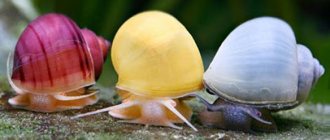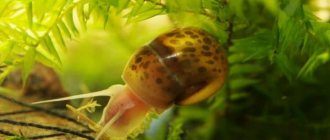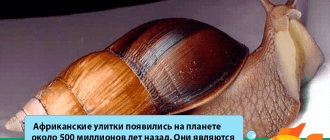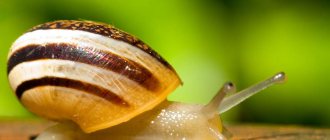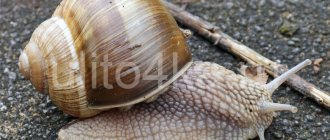Freshwater snails are found in the rivers and lakes of central Russia. These mollusks can be recognized by their large external spiral-shaped shell, from which a leg with a flat bottom surface and a pair of tentacle horns are visible. The size of snails ranges from 5 mm to 6 cm. The river snail either crawls on aquatic plants or sits quietly; it cannot swim. While moving, the snail indiscriminately eats everything that gets in its way.
Aquarium owners often want to diversify their living area and add various pets to it. River snails are no exception in this case, but in order for them to live long and please their owner, they need to create conditions that are as close to natural as possible.
Name
The snail is a representative of the animal kingdom. It belongs to the phylum mollusk, class of gastropods, or gastropods. The Latin name Gastropoda is formed from two ancient Greek words, the approximate meaning of which is “belly” and “leg”. And the Russian name for this animal - “snail” - has Old Slavic roots. It sounds similar to the adjective “hollow”. It turns out that each name reflected one of the characteristics of the mollusk. Latin concentrated on the mode of movement, and Russian emphasized the hollow house that the animal carries on its back.
Typical structure
A snail is a typical gastropod with an external shell and a body. What is surprising is that the body simultaneously performs the functions of locomotion and abdomen. Above it is a special fold called the mantle. The void between the mantle and the body is called the mantle cavity. Inside it there is an inlet siphon, which allows oxygen-enriched water to pass through, and an outlet siphon, designed to remove waste liquid. As you understand, this applies to those snails that live in water. If the animal is land, then the mantle cavity contains a primitive lung, not gills.
Brotia Pagodula
Size up to: 5-6 cm.
Brotia Pagodula - inhabitants of fast freshwater rivers, native to Thailand. Adults are less active than young ones. Most people who buy them die without clear reasons within six months, usually faster. Soil . They live on rocks; rock blocks and some sand are desirable. Water . 20-26°C, pH 7.2-8.0, requires a high amount of oxygen in the water, loves current. Nutrition . The main food is algae fouling; they also eat black beard. They also eat catfish tablets, broccoli, and spinach. Breeding . There are several successful breeding experiences, apparently Brotii Pagoda are heterosexual and viviparous. But those who achieved results here also experienced their pestilence. Compatibility . Can be kept with other species of Brotium, Neritin, small Armored Catfish, and Dwarf Shrimp. It is not advisable to keep it together with Radix (P. Tropical).
Helena
Freshwater snails: danger
The worst killers on earth are not large predators, but small, harmless snails. Although how can you call an animal harmless that is responsible for about 10,000 deaths every year? This is not an exaggeration at all. Are you interested in why freshwater snails are dangerous? How can an animal that does not have sharp fangs and long claws kill a person? Let's explain now.
Every day, a huge amount of garbage, including animal and human waste, enters fresh water bodies. Various parasites multiply massively in dirty water. Microscopic parasites from the genus Schistosoma settle on the body of freshwater snails, which infect humans.
The freshwater killer snail causes a terrible disease called schistosomiasis. A huge number of parasites penetrate the skin and begin to reproduce. According to the international classification, schistosomiasis is the second most common tropical disease in the world (after malaria). It is estimated that more than 207 million people suffer from schistosomiasis on the African continent alone, but these are only those who could seek help. According to statistics, 25% of people who get sick die.
How does infection occur?
Freshwater snails kill people by infecting water bodies with schistosome larvae. It is in their bodies that the larvae undergo the first phase of development. The life cycle of schistosomes is quite complex. People bathe, wash clothes, drink water from contaminated bodies of water, and sometimes simply wade across them. In fresh water bodies there are snails in whose bodies sporocysts settle, from which cecariae develop. They emerge from the snail's body and move freely in the water, penetrating through human skin into the circulatory system. Cecariae migrate through large vessels and capillaries to the portal vein or bladder.
During the migration process, the form of the parasites changes once again, they become adult male and female worms. The special composition of the protein structure of schistosomes makes them hardly noticeable or even invisible to the human immune system. This makes it possible for parasites to multiply in incredible numbers. The immune reaction occurs only after opposite-sex individuals have mated and laid eggs. The eggs are released back into the environment through the intestines or bladder. From the water, the eggs again enter the body of the mollusks. And then freshwater snails kill again, continuing the development cycle of schistosomes.
It takes about 65 days from the penetration of the cicarium into the skin to the development of a sexually mature individual capable of reproduction. The female is larger than the male. It can grow from 7 to 20 mm. Schistosomes live from 3 to 30 years, producing billions of eggs during this time.
The freshwater snail, which is a necessary step in the life cycle of schistosomes, is common in the waters of Africa, the Middle and Far East, South America and the Philippines.
Breeding
Sex differences
There are no gender differences, since pond snails are hermaphrodites, that is, they are endowed with both female and male genital organs.
Getting offspring
Representatives of this species are hermaphrodites; reproduction can occur either alone or in groups. Pond snail eggs can be found on the foliage of aquarium plants. The eggs are held together by mucus and form an oval pouch. Under favorable conditions, one individual can lay up to 25 such sacs in 4 months. Each clutch contains up to 80 eggs. The eggs are small in size and colorless (transparent). One month after fertilization, small snails hatch. Pond snails reach sexual maturity at 6-8 months. Small pond snails reproduce very actively; to develop a stable population, it is recommended to thoroughly wash the aquarium plants to get rid of excess clutches. Throughout their life cycle, pond snails reproduce up to 500 times.
How to understand that an infection has occurred
The symptoms of schistosomiasis are dangerous because they do not appear immediately, but when a huge number of parasite eggs accumulate in the body. Initially, after visiting dangerous areas, you should pay attention to redness and irritation of the skin from contact with fresh water bodies.
1-2 months after infection with parasites, primary symptoms appear. They are expressed in fever, chills, cough and muscle soreness. But the majority of those infected do not experience primary symptoms. They realize that they are sick only when chronic schistosomiasis develops. Symptoms of this disease are:
- severe abdominal pain;
- ascites, that is, swelling;
- bloody diarrhea;
- pain when urinating, blood in the urine;
- dyspnea;
- coughing attacks;
- increased heart rate, pain in the heart area;
- partial or complete paralysis;
- mental disorders.
Examination, tests, treatment
If, after returning from vacation or a business trip from countries where schistosomiasis is widespread, a person begins to experience strange ailments, then you should immediately contact a parasitologist or infectious disease specialist. Especially if, while exploring local attractions, a person came into contact with water from rivers or lakes. At the same time, it is not necessary to swim in a body of water where a freshwater snail lives. It is enough to sit on the shore with your feet in the water, or put your hand in the water for a long time during a boat excursion.
Symptoms of schistosomiasis are similar to other infectious diseases, so it is necessary to take several stool and urine tests. Blood tests (PCR) show the presence of a problem only in the advanced stage of the disease, since the immune reaction does not immediately appear.
In difficult cases, a colonoscopy, cystoscopy or biopsy may be necessary. Ultrasound diagnostics, X-rays, MRI and other examinations can be used to determine the degree of infection.
Praziquantel is prescribed as treatment. The dosage is calculated based on the patient’s weight, the duration of administration is determined by the doctor. To enhance the effect, it is possible to combine it with the drug “Artesunate”.
After treatment, the patient should receive an appointment for stool and urine tests to ensure that the parasites have died.
Freshwater snails. Helena Cougar
There are various species of freshwater snails that live both in open water and in freshwater aquariums. One of the species is the Helena snail. This dangerous beauty lives in Southeast Asia. It has a bright and attractive appearance and is capable of eating smaller gastropods.
The Helena shell is decorated with contrasting black and amber stripes. The head of the mollusk is elongated, like a proboscis. Helena's body is speckled and covered with thousands of black dots. Nature has provided this dangerous predator with special plate-like protection. In dangerous situations, the snail closes the entrance to the shell with a strong “door”.
Helena clams are often kept as freshwater aquarium snails. They help reduce algae, tadpoles, pond snails and other types of snails.
U. "Apple" (Asolene Spixi)
Size up to: 3.5 cm.
U. “Apple” is also called: Apple, Zebra, Zebra Apple Snail, Spixi Apple Snail. New and less common. Origin: Southeast Brazil. Heterogeneous. They lay eggs underwater. Asolene Spixi often eat their eggs. There are about 30 eggs in the clutch. About 50% hatch. Most newborns die for unknown reasons. Omnivores.
Horned snail
These freshwater mollusks belong to the well-known family Neritina. They are common in southern latitudes. They are found in the reservoirs of Japan, Thailand, the Philippines, China and Indonesia. The mollusk prefers river mouths with a rocky or sandy bottom.
The snail has natural protection in the form of sharp growths. The horns scare away predators trying to grab the snail.
The color of the shells consists of two colored stripes. One of them is yellow, the second is black. Small bright inhabitants often end up with owners of freshwater aquariums. They clean excess algae from driftwood, decorations and glass. Horned mollusks get along well with other inhabitants of aquariums, with the exception, perhaps, of the Helena snail.
Kinds
There are two main types of lawns - real, or river (river snail), and striped, or swamp. It cannot be said that they are fundamentally different from each other, but it should be noted that aquariums usually contain the “striped version” of the mollusk.
Real (river)
River meadows are larger in size (its dimensions were discussed in the previous section), and the main color of their shell is dark brown. These mollusks live in the central and eastern parts of the European continent.
Striped (swamp)
The marsh meadow, as you might guess, prefers standing water to running water. It is smaller than its river relative, but not significantly: the maximum shell height is 4 cm, the minimum is half as much. Habitat: Almost all wetlands in Europe.
The top of the shell of this mollusk is more blunt, but its tip is very sharp, and the outlet is decoratively curved upward. These snails have more spiral turns than river snails: their number ranges from 6 to 7. The gills of this mollusk also have their own differences - there are more outgrowths on their main plate, which makes their structure similar to that of a fish.
Being small in size, these snails have an undoubted advantage over the river variety (from the point of view of an aquarist): their shell has a very bright emerald tint, which gives it a sophisticated and even exotic appearance; sometimes the striped lawn is even confused with the South American ampoule.
The aquariums also contain crabs, catfish, turtles, newts, and snakeheads.
Ampularia snail
Freshwater ampularia is found in water bodies of South America and Asia. These are beautiful multi-colored mollusks with four sharp antennae on the body. The color range of ampularia is surprisingly diverse. This is a whole family of mollusks, in which there are at least 120 species, each of which has its own color. The body of the mollusk can reach 7 cm in length. Features of the species include the presence of gills and a lung. This is due to the fact that the species lives in shallow water bodies. Ampullaria have a special appendage, by extending which they can breathe atmospheric air, even while in water.
Ampoules love warm water (up to 28 °C) and are not too picky in their diet. Grinded vegetables, fish food, and small fish pieces are suitable for them. If the water in the aquarium is cold, the ampularia will go into hibernation, closing the shell with a lid.
Aquarists love members of this family because they keep the bowl clean. Ampularia pick up pieces of food and dead algae that have settled to the bottom.
Where to get shellfish
River snails can be picked up on the banks of reservoirs. Among them, Prudoviki, Luzhanka and Pagoda are often found. You should choose healthy individuals, that is, those with no cracks or chips on the shells.
Such mollusks are omnivores and do not cause much trouble, but before placing them in a common aquarium, they must be quarantined. To do this, individuals sit in a separate container for several days. Special drops are added to the water for disinfection; you can purchase them at any pet store.
melania snail
This species of gastropod is distributed throughout Africa and has a very wide range. In natural conditions, it prefers small bodies of water with slow currents. But melania does not like a rocky bottom; it prefers a muddy bed or sand. The diet of this snail is based on lower algae and semi-decomposed remains of organic matter. The melania shell is elongated with a sharp tip. The color range varies from black to light brown.
In fact, any freshwater snail whose photo you find will look beautiful and attractive. However, we must not forget that these mollusks pose a huge danger. If the owner of an aquarium wants to have such a pet, adding it to other fish, then he must understand that it is necessary to take safety measures.
Regardless of whether you caught the snails yourself or bought them at a pet store, all shellfish must be kept in quarantine. Freshwater snails are planted in an empty aquarium (without algae and other inhabitants) and kept for about 4 weeks in a weak solution of potassium permanganate. Then the animal is washed in clean water and only after this procedure is allowed into the general aquarium. Although, remembering how dangerous the freshwater snail is for humans, it is undesirable to catch this animal in natural reservoirs. Why put yourself at risk of contracting schistosomiasis?
Tylomelania
A species of freshwater snail from Indonesia in the family Pachychilidae Troschel.
Appearance
Tilomelania is a mollusk with a cone-shaped shell that can be of various colors. The shells are smooth, covered with spikes, with curls. The length of the shell can vary from 2 to 12 cm. The color combination of the body and the shell is very diverse. The eyes rise above the body on long thin legs.
Did you know? Thylomelania looks like the result of an amazing genetic experiment. The snail's trunk is similar to the trunk of an elephant. And the body is like a slice of exotic bright yellow fruit.
Lifestyle
The lifespan of this tropical species is 2-3 years. The mollusk is very fond of rocky base and water with high acidity. This species of gastropod is omnivorous and eats everything: plants, other snails, fish food. Due to the excessive gluttony of the mollusk, it is advisable to feed it 2-3 times a day with leftover vegetables. If there is a lack of nutrition, the snail will start eating aquarium vegetation.
Extremely aggressive towards other inhabitants of the ecosystem. This beauty is a natural predator, eating all shellfish that are smaller than its size, and also eats the eggs of shellfish and fish. That is why it is not recommended to house tilomelania with other species. This mollusk is bisexual. The female carries one egg and is viviparous.
Content requirements
A small aquarium can only accommodate a few shellfish. A population of 4-5 snails needs a container with a volume of at least 60 liters. Comfortable water temperature – at least +25 C, acidity at least 7.5 Ph. The water must be hard because in soft water the process of softening the sink begins. Tylomelania does not tolerate bright light, so the aquarium must be equipped with shelters where the mollusk could hide on a sunny day.
You cannot house them with other species unless you want to reduce their population.
Basics of care and feeding
To preserve aquarium vegetation, the mollusk needs to be fed several times a day with pieces of vegetables: cucumber, zucchini, tree leaves. Tylomelania readily eats fish food and aquarium organic matter.
